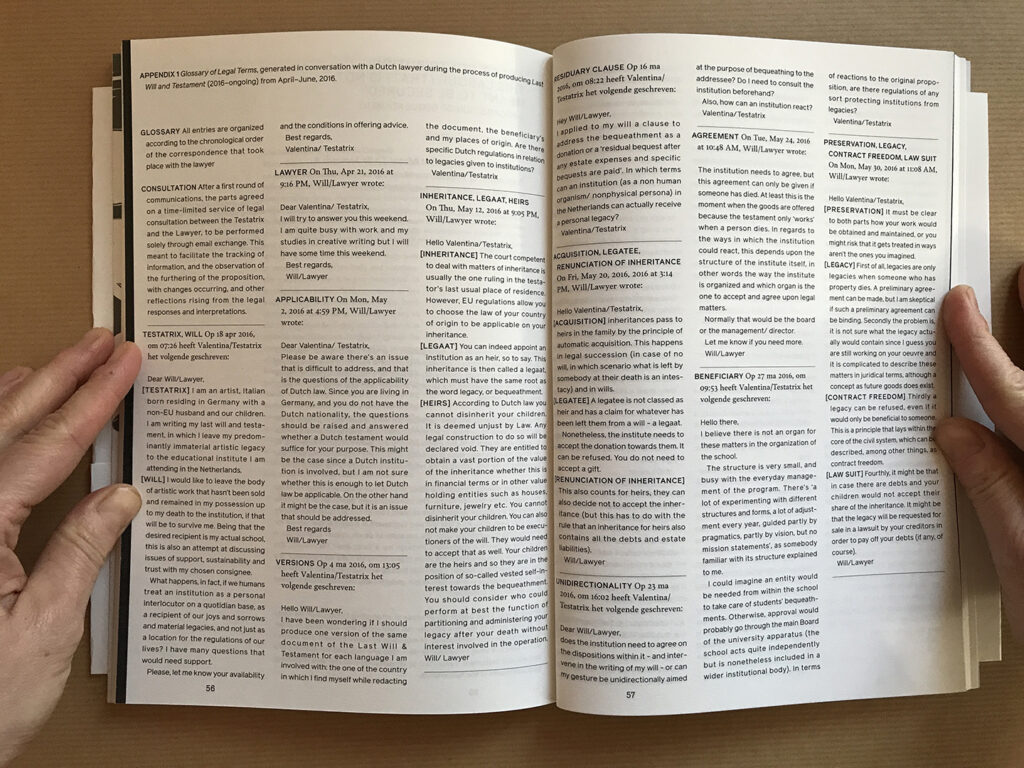This Labor (that) is not meant to be secured: a proposition of bequeathment
2021
Artistic contribution to the publication ‘ASSESSING RISK: ON STRATEGIES FOR HEALTH, SAFETY, AND WELFAREWITHIN ARTS PRACTICE’, KUNSTLICHT VOL. 41 NO 4, 2020

Guest editors Isabelle Sully and Eloise Sweetman
The artist contribution describes the premises of the proposal to bequeath my body of artistic work to the school that granted my Master in Art Praxis (see works Art to DAI, Kate, On Immunity ~ Motherboard, Felicity Bequeathment 2016 – ongoing). It responds to the editorial call for contributions on risk assessment presenting the precaution taken in response to the precarity of artistic life and working conditions, by demanding incorporation of my immaterial performative work within an institution devoted to artistic talent development. The conceptual frame of this intervention on matters of safety asks: How does risk management get complicated while working in the unshielded environment of the arts? Which measures do we individually take to regulate our own risks in artistic life and endeavors? Which limits do we encounter in these individual efforts? How do we start setting up practices of support and welfare for our precarity?
Through an autoethnographic approach, using self-reflection and anecdotal writing, the personal story delivers a case study narrating conditionings in death management and actions taken in artistic practice: from navigating chronical illness and health debt as an artist relocating in Northern Europe, to evaluating the possibility to appropriate the tool of last will and testaments and perform in the role of a proprietor who finds capital in artistic intangible work.
An appendix of material effects accompanies the narrative: an excerpt page from the handwritten holographic will; a glossary of legal terms assembled from the exchange of communications with a Dutch lawyer in matter of inheritance; the list of workspassed to the Executor that makes up the corpus that will be bequeathed as legacy to the educational institute as beneficiary.
The evidence and the writerly contribution together expose the friction between the artistic proposal and the legal frame of reference for bequeathing gestures. The effort of protecting my work clashes against the legal requirement in death management and inheritance law to protect my offspring by passing them my possessions at the end of life. Competing against each other, artistic work and offspring reduce my intention to the expectations of outcome reserved to my gender and to my artistic work.
There are questions of work evaluation entering the proposition, too. Since my declarations refer to a body of work that is mostly ephemeral, performative and linked to live acts, its definition through appraisal doesn’t easily comply with criteria for categorization in estate planning. As the law needs to see value developing in the assets to be passed, projections start on how my body of work could be performing in the future, while I insist that, instead, it is performing all along every way of narrating this proposition. This persistence is the base for elaborating a critical and productive attitude – an artistic position and practice to be maintained. In this contribution I start envisioning a series of rules of engagement with the practice and proposition of bequeathing.
They procedure is inspired by academic Maria Puig de la Bellacasa’s elaboration on Isabelle Stengers’ idea of an ‘ecology of practices’ that acknowledges obligative limitations as enabling and situating practices within bonds of relationality. I respond to the legal limitations interpreting them as constraints that oblige and form my practice: constantly challenge the personification when working with narrative structures; whenever possible, create witnessing moments; resist bureaucracy’s secrecy; avoid negotiations’ particularisation; question the economization of artistic work.
Many pending factors still act in the proposition, such as the terms for passing and the currency of the body of work: Will the school accept? Will my work find a worth that could be valuable within the school’s mode of existence? Ultimately, there’s a question around the legacy of a woman artist’s practice: If such a donation is possible only as a non-valuable asset (a surplus), what moral economy is at work, that defines (material or immaterial) practices as ‘rest, residue” in the property of the gendered subject?